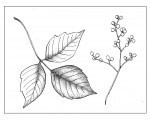
“Leaves of three, let it be.” What elementary school child doesn’t know this couplet, about one of the most dreaded plants in our New England landscape, poison ivy? At this time of year, the three green leaves start turning shades of yellow and red, joining in the fall foliage show.
Many of us still remember our first, itchy encounter with Toxicodendron radicans. Like its close relatives, poison oak and poison sumac, the plant is distinguished by the powerful skin irritant urushiol. Lacking thorns or tough woody tissue, poison ivy tries to defend itself from its many predators (primarily beetles, caterpillars, and slugs) using this chemical irritant. Deer, however, are undeterred by urushiol and include poison ivy in their long menu of suitable foods.
Poison ivy is primarily a southern species, where it co-exists with poison oak and poison sumac. In New England, the climate is too harsh for poison oak (and poison sumac only hangs on in the depths of shrubby swamps), but not for poison ivy, which is abundant in Connecticut and along the coast. Farther north, in New Hampshire and Vermont, the plant grows primarily in the bottoms of the major valleys. As you move inland and uphill from these valleys, the harsher climate limits the plant’s growth and poison ivy becomes harder to find.
In the southeastern U.S., poison ivy grows as a vine on trees, sometimes reaching three inches in diameter. As the trees grow, the ivy grows too, clinging to the trunk with tiny hairs and maintaining access to light while not having to waste energy on a strong, supportive stem.
In our climate, however, the plant does not survive the winter without the protection of snow cover, so poison ivy has adapted to grow as a low plant. It needs plenty of light, so it thrives by the side of the road, where roadside mowing removes its woodier competitors. Healthy plants might grow to a foot in height at the edge of a field. On an old stump or other fertile spot, it might grow to four feet; seldom more.
Up to 80 percent of humans are sensitive to the urushiol in poison ivy. This colorless compound is not lurking on the leaf faces themselves but rather in the sap. “Urushi” is the Japanese name for lacquer, which is made from the sap of the “urushi ki” plant, a Toxicodendron species in Asia. Urushiol passes through the skin over the course of a day or two before triggering the dermatitis. The itchy, sometimes blistering rash may last for weeks thereafter.
What should you do if you have a close encounter with Toxicondendron? Remove the sap from your skin immediately, since time is of the essence. After only 10 minutes, 50 percent of the urushiol has been absorbed into your skin. After an hour, it’s there for good. Urushiol degrades in cool water, so rinsing in a cold stream can help. So does mashing up a poultice of juicy jewelweed stems, which can often be found growing nearby.
Poison ivy prefers warm growing conditions, and the climate of New Hampshire and Vermont is becoming warmer. This alone would lead to the plant’s spread locally, but scientists at Duke University recently discovered another factor working in poison ivy’s favor: the increasing concentration of carbon dioxide in the atmosphere - a result of burning fossil fuel - dis-proportionally favors the growth of vines. Whereas most plants are typically limited by a lack of nitrogen or phosphorus or potassium (the N-P-K found in commercial fertilizer), some vines are limited by CO2. As we continue to burn fossil fuel, the conditions for poison ivy are steadily improving.
The Duke researchers moved the clock ahead to the estimated amount of carbon dioxide that will be in the atmosphere of 2050: 570 parts per million. At this concentration of CO2, poison ivy grew twice as fast as it does today, at 380 parts per million. In addition, the plant produced a higher percentage of unsaturated urushiol, the type that is more apt to cause dermatitis. According to this study, along the roadsides of the future, there will be more poison ivy, and it will be more potent.
Poison ivy is not without its redeeming qualities, at least in the North Woods. Come winter, our northern forests provide relatively poor pickings for wildlife. Where they are available, poison ivy berries are rich in fats, and the berries can persist on the plant through the season. Toxicodendron berries are eaten by bluebirds, myrtle warblers, and 26 other local bird species. The birds, in turn, disperse the seeds as they migrate. Poison ivy, like cherry, shadblow, grape, oak, and many other species, is part of the dynamic bird-dispersed landscape of our region.

